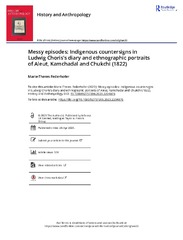Messy episodes: Indigenous countersigns in Ludwig Choris’s diary and ethnographic portraits of Aleut, Kamchadal and Chukchi (1822).
Permanent link
https://hdl.handle.net/10037/29177Date
2023-04-26Type
Journal articleTidsskriftartikkel
Peer reviewed
Author
Federhofer, Marie-TheresAbstract
Examining Ludwig York Choris’s diary, which was first published in 1999, and representations of Aleut, Kamchadal, and Chukchi people in his Voyage pittoresque autour du monde (Paris 1822), my article discusses methods of aesthetic and scientific visualization in an early nineteenth-century research expedition. The album was the outcome of Choris’s participation in the Russian circumnavigation of the globe (1815–1818) and is an invaluable ethnographic record of Indigenous cultures in the North Pacific. I use the concept of ‘Indigenous countersigns’ (Douglas 2014) to investigate whether Aleut, Kamchadal, and Chukchi presence is inscribed in this little studied European work on Indigenous peoples and in Choris’s private journal. Going beyond the common binary of ‘us’ and ‘the others’, I discuss how Indigenous presence is still traceable in his texts. Further questions addressed concern the illustrations’ intended purpose and the influence of the contact zone wherein Choris and the Indigenous actors had to meet for the drawings to be made in the first place. This analysis is supplemented with unpublished letters of Choris to Adelbert von Chamisso, another member of the Russian circumnavigation, which can be found in the Staatsbibliothek zu Berlin – Preussischer Kulturbesitz, and passages of Otto von Kotzebue’s official expedition report (1821). References are made to around thirty, hitherto unknown watercolours by Choris, which are part of the Beinecke Collection, Yale.
Publisher
Taylor & FrancisCitation
Federhofer. Messy episodes: Indigenous countersigns in Ludwig Choris’s diary and ethnographic portraits of Aleut, Kamchadal and Chukchi (1822).. History and Anthropology. 2023Metadata
Show full item recordCollections
Copyright 2023 The Author(s)


 English
English norsk
norsk
